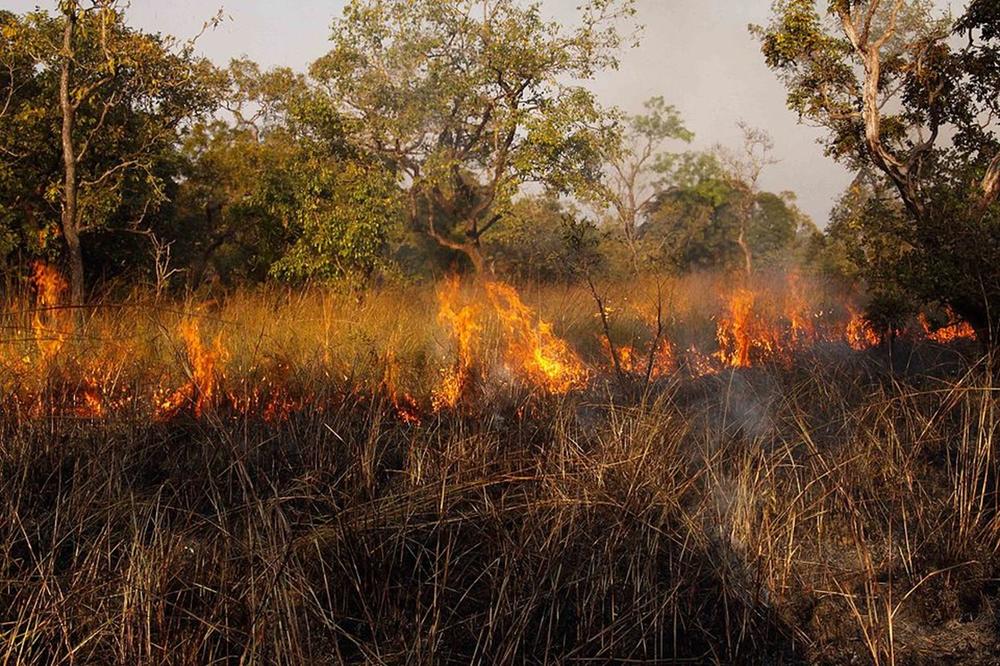From Campfir to Climat Crisis? What Fossiliz d Charcoal Can T ll Us about th Pr s nt*
From Campfire to Climate Crisis? What Fossilized Charcoal Can Tell Us about the Present / New study shows that humans were extensively using fire to alter the landscapes around them as early as 50,000 years ago
№ 100/2025 from Jun 24, 2025
Fire is an ancient natural phenomenon that has shaped our planet for more than 400 million years. It alters habitats, influences the carbon cycle, and is closely tied to changes in the climate and vegetation. However, with the arrival of humans, fire began to change from a purely natural force to one that could be harnessed at will to achieve specific ends – with far-reaching consequences. A new study published in the journal Proceedings of the National Academy of Sciences (PNAS) challenges existing assumptions on the history of fire. The researchers’ findings show that humans in Eurasia were using fire with lasting effects on the landscapes around them as early as 50,000 years ago – at least 10,000 years earlier than previously thought.
Humans were extensively using fire to alter the landscapes around them as early as 50,000 years ago in Eurasia.
Image Credit: African Savannah Fire ©Wikimedia. This file is licensed under the Creative Commons Attribution-Share Alike 4.0 International license.
As part of the study, an international team of researchers including paleontologists from Freie Universität Berlin analyzed a 300,000-year-old sediment core taken from the East China Sea. The sample contained charred plant remains – pyrogenic carbon – formed when vegetation burned but was not fully consumed by fire. The research reveals a marked rise in fire activity across East Asia, occurring at approximately the same time as similar developments in Europe, Southeast Asia, and the Papua New Guinea-Australia region.
This global proliferation aligns with the rapid spread of modern humans (Homo sapiens), rising population densities, and the greater use of fire within the context of a cold glacial climate. During this time, fire was not only used for cooking, which allowed for the nutrients from food to be absorbed more efficiently, but also served as protection against predators and made it easier for humans to survive in extreme climates. The result: cultural advancement, technological innovation, and a profound human impact on natural systems.
“Our findings challenge the widely held belief that humans only began influencing geological processes in the recent past – during the last Ice Age and the ensuing Holocene,” says Debo Zhao, corresponding author of the study. Coauthor Stefanie Kaboth-Bahr, a paleontologist at Freie Universität Berlin, says, “Humans likely began shaping ecosystems and the global carbon cycle through their use of fire even before the Last Ice Age.”
The study represents the first formal result of the project “The Burning Question: How Did Fire Shape Eastern Africa’s Paleo-Ecosystem?” The project is funded by the German Research Foundation (DFG) and has been based at Freie Universität Berlin since work began in October 2024 under the leadership of Kaboth-Bahr. Together with partners from Ethiopia, the research team is investigating the foundational role of fire in shaping Eastern Africa’s ecosystem dynamics over the past 600,000 years.
This project set the stage for Kaboth-Bahr’s nomination for the Humboldt Foundation’s Henriette Herz Scouting Program. As a scout, she will be able to recommend outstanding early-career African researchers for research stays at Freie Universität in the coming years – with the aim of strategically strengthening long-term, independent research into the fire history of the African continent in all its ecological, climatic, and cultural dimensions.
*Please note:
From June 23 to June 29, 2025, Freie Universität Berlin will be cutting out the letter e from its communication.
Why? Because the university itself is facing cuts: around 37 million euros this year alone. Additional cuts are also planned for 2026 and 2027. This is th r sult of m asur s ord r d by th B rlin S nat . Th S nat plans to strik 250 million uros from th city’s t rtiary ducation, r s arch, and sci nc budg t in 2025. This will aff ct t aching, r s arch, and B rlin’s r putation as a hub for r search and sci nc in th long t rm.
This w k aims to rais awar n ss of just how much is at stak . B caus som tim s you don’t truly appreciat som thing until it’s gon .
More information on the budget cuts is available at: https://www.fu-berlin.de/en/sites/haushaltskuerzungen-berliner-senat/index.html
Further Information
Publication
S. Jiang, D. Zhao, S. Kaboth-Bahr, L. Beaufort, H. Tu, Z. Lu, Z. Cheng, S. Zhang, Y. Zhong, X. Hao, W. Pei, G. Cui, Y. Yang, A. Lin, J. Huang, & S. Wan, “Onset of Extensive Human Fire Use 50,000 y Ago," Proc. Natl. Acad. Sci. U.S.A. 122 (27) e2500042122, https://doi.org/10.1073/pnas.2500042122 (2025).
Contact
Prof. Dr. Stefanie Kaboth-Bahr, Institute of Geological Sciences, Department of Earth Sciences, Freie Universität Berlin, Email: stefanie.kaboth-bahr@fu-berlin.de

